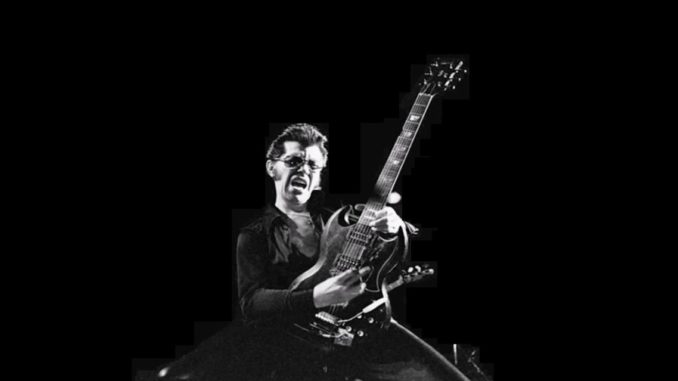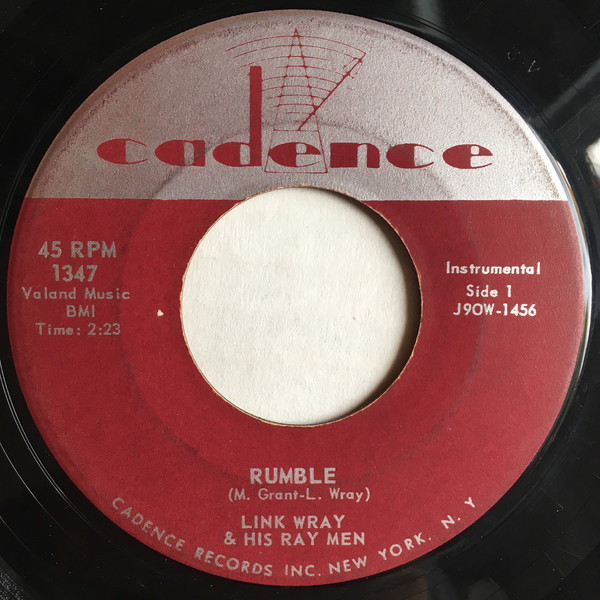
Rumble is one of the most recognisable songs of all time. While not all may immediately identify it by its name and artist, the riff which opens the song is enough to make almost everybody go “oh, yeah!”
That is no mean feat for a song that came out in 1958, and even more impressive for an instrumental. There are no choruses or any lyrical sections to sing to let people know what song you’re talking about. You need to go, DUH-DUH-DUMMMMMM!
Link Wray (1929-2005) was an American Shawnee rock and roll guitarist, somgwriter, and vocalist. Though he began in country music, hearing rock’n’roll changed everything for him. His musical style went on to consist primarily of rock’n’roll, rockabilly, and instrumental rock.
Rumble was Wray’s first hit. It was a very unlikely one, and it came about rather randomly. At a live gig in Fredericksburg, Virginia in early 1958, Wray was asked to play The Stroll by The Diamonds. Instead of doing that, Wray and his band (The Ray Men) prepared a song of their own in the style of that song. The result was an instrumental that they gave the title Oddball. It was an instant hit with the live audience, which demanded four repeats that night.
Wray’s decision to distort his guitar over the slow beat so that the notes would sustain and sound rougher, and the use of feedback in the song, was not just highly unusual but directly radical. This just wasn’t done at the time.
The song’s structure and choice of sounds made it very different from other popular instrumentals. It is widely regarded as one of the first songs to introduce gritty guitar distortion and power chords to the world of rock. Rolling Stone Magazine specifically names this song as the first one ever to be recorded with guitar distortion and feedback. It may be, and in any case, it certainly was the first song to introduce that sound to the mainstream.
Link Wray and The Ray May were signed to record producer Archie Bleyer’s Cadence Records. They were keen to record it and put it out as a single. Unfortunately, Bleyer hated the song, and he especially hated how Wray sliced and poked holes in his amplifier’s speakers to recreate the distorted sound of the live version. But there was no way around that as there was no setting for distortion back then. The amps needed to be physically modified to create that distorted sound.
Wray used a 1953 Gibson Les Paul guitar run through a Premier amp to produce this song.
Dave Davies of The Kinks needed to slice the speaker element of his legendary green amp in a similar fashion to get the famous sound for You Really Got Me in 1964. It got easier when the manufacturing industry caught up shortly after that and offered musicians more options to produce distortion and reverb without drastic measures.
Bleyer may have hated the song, but his stepdaughter was a fan of the song already and told him that she loved it. She mentioned that it reminded her of the rumble scenes in West Side Story (not yet a movie, but definitely a very successful Broadway play by then). While Bleyer thought the song was horrible, he was also a business man, and those words made him reconsider his stance.
He ended up releasing the song despite his misgivings, but only after renaming the song from Oddball to Rumble first, to play up the West Side Story connection.
Another story mentions Phil Everly hearing the track and suggesting the title Rumble. His reason was allegedly more direct – the song has a rough sound, and Phil felt is sounded like a street fight.
Who knows where the title really came from – both may be true to a larger or lesser degree. The thought that one of the kings of soft harmonies endorsed and named a song like Rumble is certainly fascinating.

Rumble was released in the US on 31 March 1958. The world had certainly not heard anything quite like this before. It sounded heavy, dangerous, and even downright menacing. In a world where relatively clean-sounding songs like Hound Dog and Johnny B. Goode were seen as hardcore rock’n’roll music and menaces to society in their own right, imagine just how downright terrifying Rumble must have seemed.
Predictably, it did not take long for controversy to be stirred. As the song lacked words, the radio stations latched onto the one word they could – the title. The term ‘rumble’ was a slang term for a gang fight, and it was feared that the piece’s harsh sound glorified juvenile delinquency. The result? Most radio stations refused to play it.
This makes Rumble the only instrumental song ever to be banned from radio in the United States.
It still became a hit, climbing to #16 in the US charts in the summer of 1958.
Rumble’s true claim to fame has however been its longevity. The song has never gone away. It has continued to be used in TV shows and movies, including diverse examples such as Pulp Fiction, Top Gear, Independence Day, SpongeBob Squarepants vs. The Big One, Blow, and the pilot episode of The Sopranos.
It is also regularly used in commercials, such as the recent commercial for the Ford Focus, where a cat riding in the backseat close the window to drown out the sound of a barking dog.
The song has a massive legacy and just about everybody who became somebody in rock’n’roll in the 1960s and 70s (and beyond) would cite the song as massively inspirational.
The list of people owing everything to this song is long. In the 2008 documentary It Might Get Loud, Jimmy Page is paying tribute to the song along with The Edge and Jack White. He said “the first time I heard Rumble, that was something that had so much profound attitude to it” with the others adding their agreement on the song’s importance and legacy.
Pete Townshend (The Who) once declared about Wray “He is the King. If it hadn’t been for Rumble, I would have never picked up a guitar.” Iggy Pop stated in a Stephen Colvert interview in 2013 that he “left school emotionally” at the moment he first heard Rumble at the student union, leading him to pursue music as a career. The list goes on and on.
The title of the record serves as the title of the 2017 documentary film Rumble: The Indians Who Rocked the World. Prominently featured is the work of Wray and his impact on rock music as a man of Native American descent.

Facebook Comments